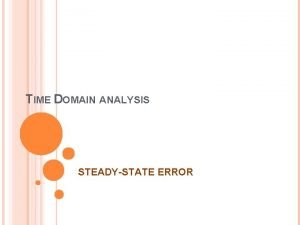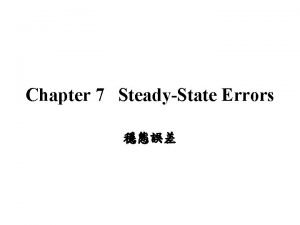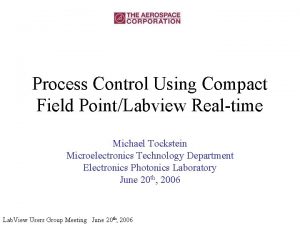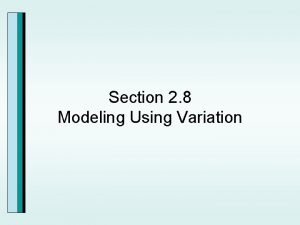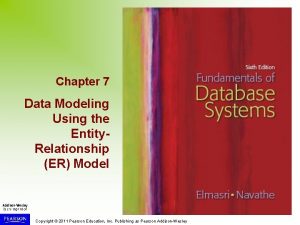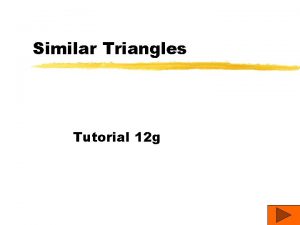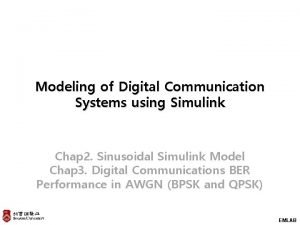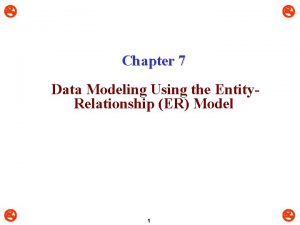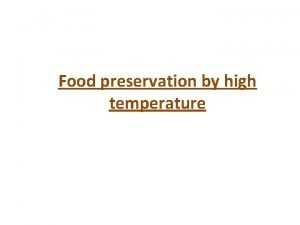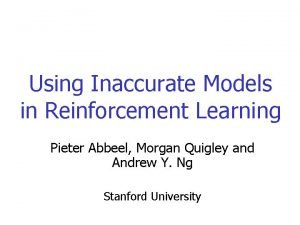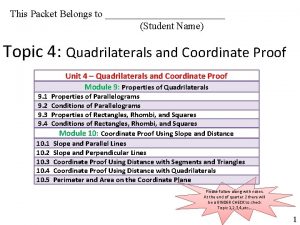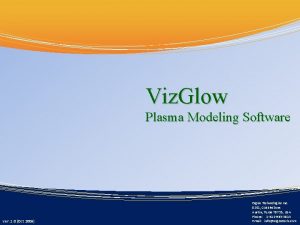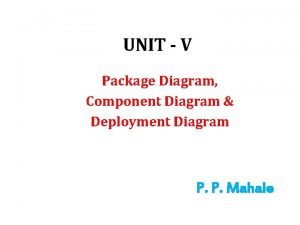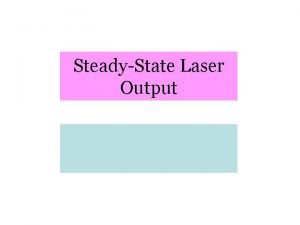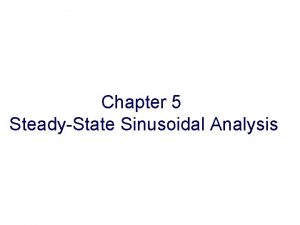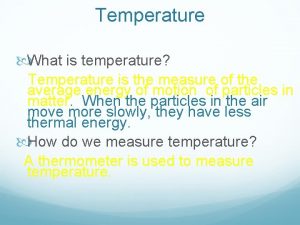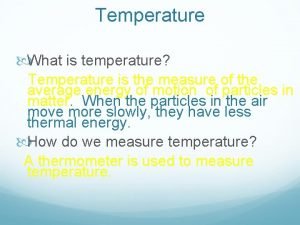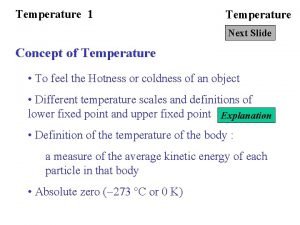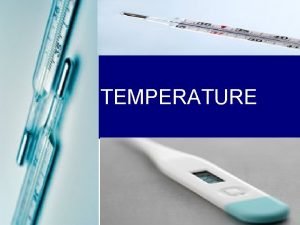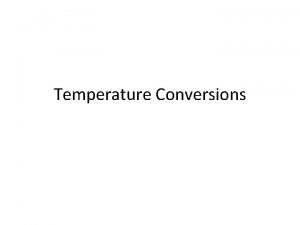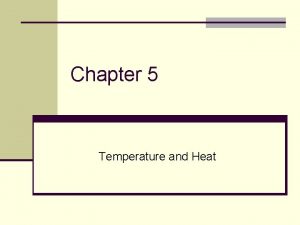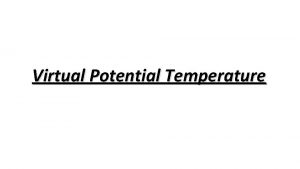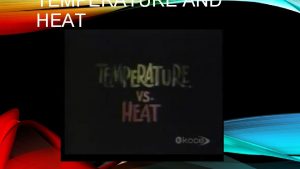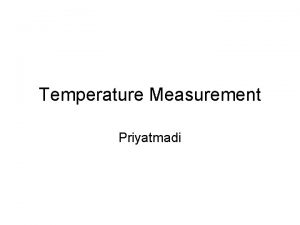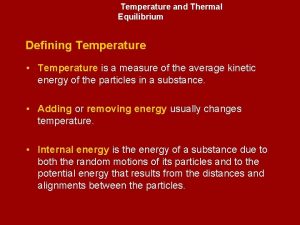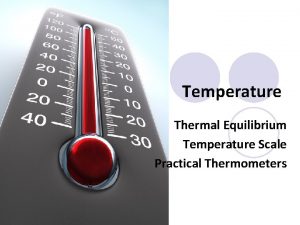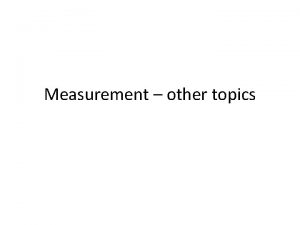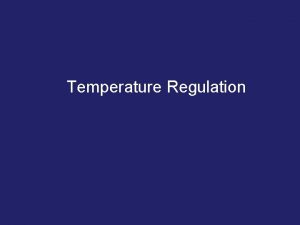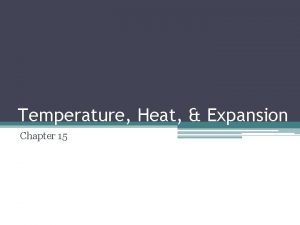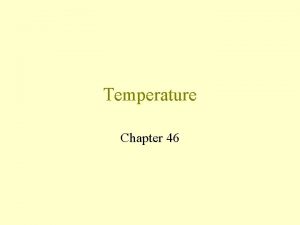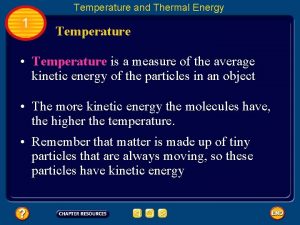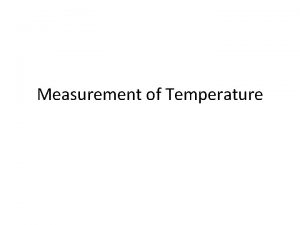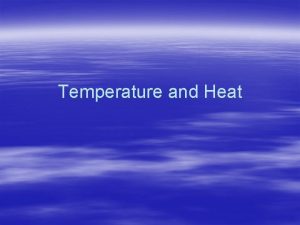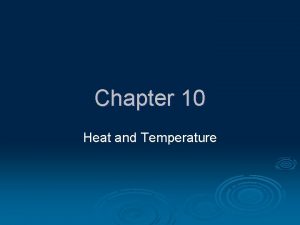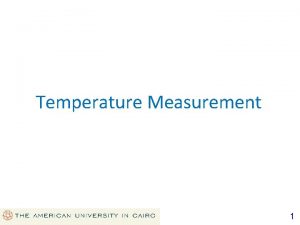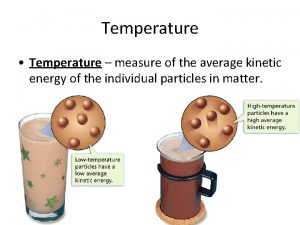Modeling of PV module temperature using steadystate models





























- Slides: 29

Modeling of PV module temperature using steadystate models: analysis for different climates Elena Barykina, Cv. O University Oldenburg, Energy Meteorology Group 30. 03. 2017 7 th PVPMC Workshop, Lugano, Switzerland

Outline 1. Motivation 2. Steady-state models 3. IEC 61853 part 2: Faiman model 4. Faiman parameters: sensitivity analysis for sites with different climates 5. Model comparison 6. Conclusions 30. 03. 2017 7 th PVPMC Workshop, Lugano, Switzerland

Motivation PV performance modeling step Solar Irradiance Ambient Temperature Module Temperature Mounting, module physical properties 30. 03. 2017 7 th PVPMC Workshop, Lugano, Switzerland Wind Speed

Motivation PV module temperature models Thermal response Math Input data Steady-state Dynamic Neglect t ~ 7 -10 min Simplified heat transfer equations Heat transfer equations Easy to use Numerical solution is needed Model parameters can be site specific: measurements are required Module layers physical properties are required Low resolution ( weather prediction data, satellite images) High resolution data 30. 03. 2017 7 th PVPMC Workshop, Lugano, Switzerland

Motivation PV performance modeling with input data from weather prediction models and satellite retrieved irradiance Steady-state model: Faiman (IEC 61853 -2) Parameters of the model can be found in literature or fitted from data How suitable are the parameters for a particular location and module technology? 30. 03. 2017 7 th PVPMC Workshop, Lugano, Switzerland

Data 5 sites with different climate (PVKLIMA project) Site Cologne, DE Ancona, IT Tempe, US Thuwal, SA Chennai, IN Tilt <Tmod>, °C <Gpoa>, W/m² 35° 33. 5° 25° 15° 21 25 39 33 33 297 382 565 522 440 Estimation of model parameters: 30 -sec data (2 weeks, 6 months) Model validation: 15 -min averages (1 year) Parameters are defined for 4 technologies: poly. Si, Cd. Te, CIGS, a. Si 30. 03. 2017 7 th PVPMC Workshop, Lugano, Switzerland

Data Fig. 1. Frequency distribution of the module temperature for one year data. 30. 03. 2017 7 th PVPMC Workshop, Lugano, Switzerland

Data Fig. 2. Frequency distribution of the wind speed for one year data. 30. 03. 2017 7 th PVPMC Workshop, Lugano, Switzerland

Steady-state models Standard/NOCT model (1) Skoplaki model (2) (2 a) 30. 03. 2017 7 th PVPMC Workshop, Lugano, Switzerland

Steady-state models Mattei model (3) (3 a) (3 b) Sandia model (4) 30. 03. 2017 7 th PVPMC Workshop, Lugano, Switzerland

IEC 61853 -2: Faiman model Fig. 3. Gpoa/(Tmod-Tamb) plotted against the wind speed for two weeks of measurements and corresponding linear fit to the data for poly. Si module 30. 03. 2017 7 th PVPMC Workshop, Lugano, Switzerland

IEC 61853 -2: Faiman model Data filters - Low irradiance filter Irradiance values below 400 W/m² - Irradiance fluctuations filter Irradiance values in 10 min after the irradiance varies by more than ± 10% from the maximum to minimum value during the preceding 10 min - Wind fluctuations and gusts filter Wind speed values in a 10 -min interval after and including deviations below 0. 25 m/s and gusts larger than +200% from a 5 -min running average - Low and high wind speed filter Wind speed data when the 5 -min running average is less than 1 m/s and greater than 8 m/s It is recommended to use 5 -sec temporal resolution measurements and at least 10 days of data 30. 03. 2017 7 th PVPMC Workshop, Lugano, Switzerland

IEC 61853 -2: Faiman model Note: we used 30 -sec measurements Irradiance fluctuations filter was modified: reject G(i) and next 10 minutes if |∆G(i) | > max(5 W/m² , 0. 1 * ∆G ), where ∆G(i) = G (i) − G (i − 1) – irradiance increments, ∆G = Gmax − Gmin – is the difference between maximum and minimum values within the preceding 10 minutes 30. 03. 2017 7 th PVPMC Workshop, Lugano, Switzerland

Faiman parameters After filtering we can define the Faiman parameters using linear fits Site Colgone, DE u 0, W/°C m² two weeks 34. 7 u 0, W/°C m² six months 35. 7 u 1, Ws/°C m³ two weeks 7. 78 u 1, Ws/°C m³ six months 8. 22 Ancona, IT 41. 2 41. 9 3. 20 3. 95 Tempe, US 36. 4 32. 1 4. 51 6. 08 Thuwal, SA 31. 8 39. 7 5. 61 3. 06 Chennai, IN 28. 6 30. 1 4. 45 4. 75 mean std, % 34. 5 4. 8 14 35. 9 5. 0 14 4. 44 1. 0 22. 5 4. 46 1. 28 29 The Faiman parameters defined from two weeks (April) and six months of measurements for poly. Si module. 30. 03. 2017 7 th PVPMC Workshop, Lugano, Switzerland

Faiman parameters - two weeks - six months - average over all sites - literature values Fig. 4. Contour plots for rmse and mbe of the modeled module temperature for poly. Si module at site Cologne and the Faiman parameters. 30. 03. 2017 7 th PVPMC Workshop, Lugano, Switzerland

Faiman parameters - two weeks - average over all sites - six months - literature values Fig. 5. Contour plots for rmse and mbe of the modeled module temperature for CIGS module at site Tempe and the Faiman parameters. 30. 03. 2017 7 th PVPMC Workshop, Lugano, Switzerland

Faiman parameters 1. The similar behaviour is observed for all sites and modules: 'best performance ellipse' 2 -2. 5 °C rmse 2. Exact values of the Faiman parameters are not crucial for the accuracy of the modeled module temperature 3. Although the values derived from 2 weeks and 6 months differ from each other they give the same accuracy of the modeled module temperature for the whole year 30. 03. 2017 7 th PVPMC Workshop, Lugano, Switzerland

Model comparison Fig. 6. Rmse (left) and mbe (right) of the modeled module temperature using different steady state models: Standard (NOCT), Skoplaki (SK), Mattei (M 1, M 2), Sandia (SA), Faiman (FA) 30. 03. 2017 7 th PVPMC Workshop, Lugano, Switzerland

Model comparison 30. 03. 2017 7 th PVPMC Workshop, Lugano, Switzerland

Model comparison 30. 03. 2017 7 th PVPMC Workshop, Lugano, Switzerland

Conclusions 1. Faiman parameters are site specific 2. Representative dataset for a given site results in reliable values of parameters 3. The steady-state models have similar performance 30. 03. 2017 7 th PVPMC Workshop, Lugano, Switzerland

Acknowledgements The work is funded by the German Federal Ministry for Economic Affairs and Energy (BMWi FKZ 0325517 A). TÜV Rheinland, Markus Schweiger and Werner Herrmann Literature The results are published: Barykina, E. , Hammer, A. , 2017. Modeling of photovoltaic module temperature using Faiman model: Sensitivity analysis for different climates. Sol. Energy 146, 401 -416. Literature values of Faiman parameters: Koehl, M. , Heck, M. , Wiesmeier, S. , Wirth, J. , 2011. Modeling of the nominal operating cell temperature based on outdoor weathering. Sol. Energy Mater. Sol. Cells 95, 16381646. 30. 03. 2017 7 th PVPMC Workshop, Lugano, Switzerland

Thank you for your attention! 30. 03. 2017 7 th PVPMC Workshop, Lugano, Switzerland

Supplementary materials





 Steady state error in control system
Steady state error in control system System type 0 1 2
System type 0 1 2 Helen erickson biography
Helen erickson biography Relational modeling vs dimensional modeling
Relational modeling vs dimensional modeling Difference between curie temperature and neel temperature
Difference between curie temperature and neel temperature Difference between curie temperature and neel temperature
Difference between curie temperature and neel temperature Ferromagnetis
Ferromagnetis Backplane for compact fieldpoint
Backplane for compact fieldpoint What is the difference between models & semi modals?
What is the difference between models & semi modals? Modeling using variation
Modeling using variation Data modeling using entity relationship model
Data modeling using entity relationship model Lesson 12 modeling using similarity
Lesson 12 modeling using similarity Modeling of digital communication systems using simulink
Modeling of digital communication systems using simulink Modeling of digital communication systems using simulink
Modeling of digital communication systems using simulink Company er diagram
Company er diagram C device module module 1
C device module module 1 Control of temperature in food preservation
Control of temperature in food preservation Mamdm
Mamdm Using functions in models and decision making
Using functions in models and decision making Multiplying decimals using area models
Multiplying decimals using area models Lesson 3 using economic models
Lesson 3 using economic models Problem solving using algebraic models
Problem solving using algebraic models Using inaccurate models in reinforcement learning
Using inaccurate models in reinforcement learning Module 10 coordinate proof using slope
Module 10 coordinate proof using slope Module 10 coordinate proof using slope and distance
Module 10 coordinate proof using slope and distance Using system.collections
Using system.collections Dtfd switch
Dtfd switch Virtual reality modeling language
Virtual reality modeling language Plasma simulation software
Plasma simulation software Common modeling techniques of deployment diagram
Common modeling techniques of deployment diagram
